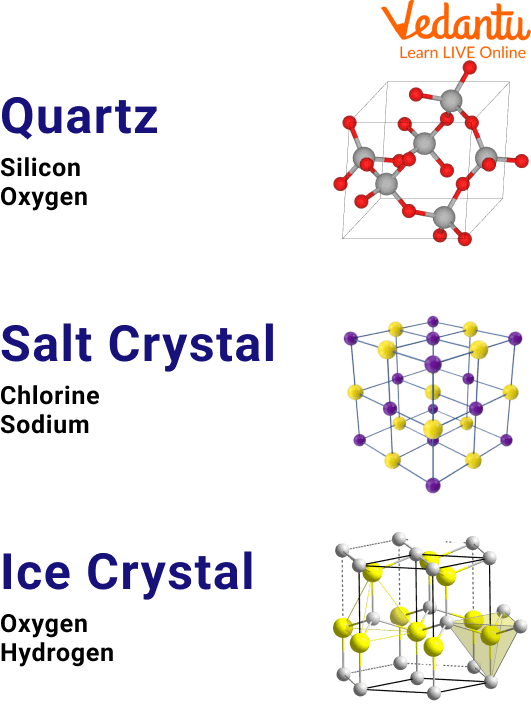




What are Crystals?
rystal is a solid form of particles that exist everywhere around us and comes to use in our daily lives. Here, we will discuss how crystals grow, where do crystals come from, and much more about crystals. Crystals are mainly made up of atoms. Crystal formation takes place when different molecules come and fit together. Crystals are used by us in different areas of our life.
What are Crystals, and How are they formed?
When different atoms, ions, or molecules form a set of designs and are arranged accordingly, it leads to the formation of crystals. These atoms, ions, or molecules repeat themselves to form crystals.
The unit cell is considered to be the base structure or the building block of the crystal form. This unit cell is built of atoms, ions, or molecules that repeat themselves to form a solid structure. This whole process of how crystals are made is called crystallisation.

Crystallisation
The crystals are generally formed when some type of liquid starts cooling down and ultimately creates a solid structure. This is the process of how crystals form in rocks. They mainly develop when liquid rocks like magma start to cool down. Different valuable and expensive crystals like a diamond, rubies, etc are formed in nature through this process of crystallisation.
Another process through which crystals can form is through evaporation. When water starts evaporating from a mixture, leaving solids or crystals behind in the mixture. This process is common to form salt crystals and separate them from water.
Some of the characteristics important for the crystal are mentioned below:
They are firm and rigid in structure.
They hold a definite shape that remains fixed.
One cannot compress the crystal structures.
Unique Properties of Crystals
The crystals can be formed in different shapes like triangle squares, rectangles, etc., depending on the structuring of atoms during the initial formation of crystals. Moreover, crystals can have very flat surfaces, which are known as facets.
The smaller molecules which come together while the formation of bigger crystals generally represent the same shape. The smaller structures and the bigger structures remain the same irrespective of the number of ions or atoms involved.
There are seven basic structures involved with the shape of atoms which are mentioned below-
Cubic
Trigonal
Triclinic
Orthorhombic
Hexagonal
Tetragonal
Monoclinic
Apart from the seven mentioned shapes, there are a few interesting shapes that have unique structures.
Interesting and Unique types of Crystal Formation
Snowflake Formation
Ice formation, which comes down from the sky when water freezes in the clouds form the snowflake formation. This only occurs only when snowfall happens and hence is a unique formation.
Quartz
Quartz is a hard mineral and crystal and is considered a gemstone that has a unique structure for a crystal.
Diamond
These are the most valuable and expensive crystals existing on the earth. Apart from being used in pieces of jewellery, diamonds are the type of crystals that are used as tools as well. Diamond is considered to be an allotrope of carbon.

Unique Crystals
Fun Facts of How are Crystals Made
Some of the interesting facts about how do crystals form are as follows:
There is a specific study based on crystal formation and its attributes known as crystallography.
The crystals contain several minute structures invisible to the naked eye, which come together to form a bigger structure that is visible to us in everyday life.
Liquid crystals are also an essential aspect of our everyday life. The computer screens and the television which we look at daily contain liquid crystals in their monitors and screens.
Different types of crystals are very popular in their use in jewellery since they have lustrous properties and a shiny appearance.
Uniquely enough, some living organisms are also capable of producing crystals.
Summary
Crystals are present all around us and are made up of small infinite structures through the process of crystallisation. No one can analyse how crystals are made and occur in nature in different forms. After reading this article you might have gotten the answer to how crystals grow, how crystals form in rocks, and where do crystals come from. I hope this article will help you to understand more about crystals. If you have any doubt do ask in the comments.
FAQs on How do Crystals form?
1. Is crystal structure present in the rocks?
Depending on the temperature and the pressure conditions present around the atmosphere, crystal structures might or might not be present on the rocks. There are several sources where crystals are present and can be obtained through. Rocks are one such source where crystals are supposed to be found but are not mandatory.
Some other places where crystals are said to be found are under the ground, such as gold crystals and diamonds, whereas they can also be found near the location of different hot springs.
2. How is the shape of the crystals determined?
Several factors determine the shape of crystals, such as the length, size, and angles of their faces. Different types of crystals have different lattices. For example, Cubic or isometric type crystals belong to the crystals centralised on a cube structure.
Different crystals tend to contain different shapes. This occurs when small millions of atoms come together to align themselves in a particular manner and arrange them, hence forming a bigger structure that looks like crystals to our eyes.
Although, one cannot determine the shape the crystal is about to form during the process of its making through naked eyes.
3. What are crystals used for?
Holding crystals or placing them on your body is thought to promote physical, emotional and spiritual healing. Crystals supposedly do this by positively interacting with your body's energy field or chakra. While some crystals are said to alleviate stress, others purportedly improve concentration or creativity.









